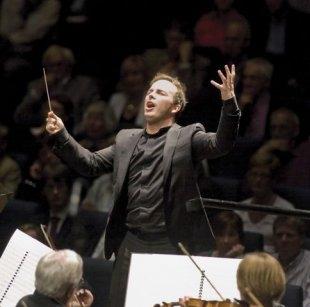A programme of French music under the baton of the LPO’s talented young principal guest conductor Yannick Nézet-Séguin should be a treat. Nézet-Séguin’s affinity for French textures and gestures has already been amply proved, as has the orchestra’s own aptitude for them, yet whatever was happening to the Fauré Requiem last night at the Royal Festival Hall was neither polished nor delightful. To attribute it simply to a bad day might be the kindest thing, but when you take into account the sold-out hall, the Saturday-night profile of the concert and all the people who had come to London’s major classical venue expecting a quality performance of core repertoire, such lazy musicianship deserves neither kindness nor the applause the audience gave so generously.
The first half – Franck’s Symphony in D minor – was unquestionably the lesser of two evils. Neglected and something of a maverick work, its unorthodox three-movement structure, casual dalliance with sonata form and verbose self-referentiality make it an easy target (Gounod famously described it as “incompetence pushed to dogmatic lengths”). With an overgrown structure not quite supported by its miniature themes, it relies on precision of textures and a carefully calibrated arc of emotion if it is not to stray into the territory of the absurd.
Yet there are some glorious colours; the fretful first subject of the opening Lento is shaded by doubt lurking in the brass, the delicate neuroses of the oboe (beautifully rendered by Ian Hardwick) and the uncertain temper of the strings. The symphony’s cumulative effect is more potent than its fragmented melodies should permit, and while we got plenty of detailed gestural work from the orchestra there was a certain scope lacking. This is music that moves (admittedly rather incoherently) from despair to wry comedy by way of ecstasy; what we got was a rather more polite and non-committal series of emotions -Gallic shrugging instead of fiery French melodrama.
There was also rather too much sloppiness for my taste. The harp and pizzicato string accompaniment in the Allegretto was less than precise, the strings generally lacked much sense of ensemble attack, and while a poorly tuned harp is never ideal it is positively criminal in a movement ending with a solo harp arpeggio. Ouch.
The Fauré that followed saw the addition of the London Philharmonic Choir as well as soloists Gerald Finley (pictured below) and Sally Matthews. Using the composer’s final orchestration from 1900 (demanding by far the largest orchestra), the LPO were able to retain some good chunks of their musicians, magnificently flanked by a full complement of eight double basses.
 The dramatic pianissimo is the enemy of the amateur choir. Exposing every hiss, crack and shallow breath, it can also spread fear like typhoid through the ranks. Making few concessions to his singers, Nézet-Séguin made something of a feature of these extreme dynamics, losing vocal tone, support and spin to the sound while gaining really very little return. Diction was all but nil (Matthews single-handedly outdid the entire choir with hers), and the intensity that should characterise the desperate exhortation of the Requiem’s opening – “Requiem aeternam dona eis” – was limp and lacking.
The dramatic pianissimo is the enemy of the amateur choir. Exposing every hiss, crack and shallow breath, it can also spread fear like typhoid through the ranks. Making few concessions to his singers, Nézet-Séguin made something of a feature of these extreme dynamics, losing vocal tone, support and spin to the sound while gaining really very little return. Diction was all but nil (Matthews single-handedly outdid the entire choir with hers), and the intensity that should characterise the desperate exhortation of the Requiem’s opening – “Requiem aeternam dona eis” – was limp and lacking.
While the men and altos did well enough (with the tenors deserving a particular mention for the bravery of their “Hosanna” entry) the sopranos were a horror show. Flat, breathy and scooping into every entry, this was the stuff of parochial choral societies, and under such attack Fauré’s expansive melodies stood no chance. The orchestra did little to help, with the harp (still out of tune) and organ spectacularly getting a beat out during the "In paradisum", leaving something of a blot on the celestial horizon.
I’d love to say that the soloists redeemed matters but, while two unquestionably lovely singers, they were ill chosen for this material. Finley’s strength is as a lyric baritone, and neither the declamatory strength of the "Libera me" nor even the more floated "Hostias" seemed to settle, lacking resonance and sitting a little under the note throughout. Less Day of Judgement and more day out in the Malvern Hills. Matthews also misjudged the tricky RFH acoustic, with an almost wilfully contained "Pie Jesu". Her trademark dark vowels stuck out badly, distorting the simplicity of the syllabic setting.
More rehearsal time; a more sensitive approach to amateur singers; a clearer sense of dramatic architecture: last night’s concert could have been improved so easily. I don’t really want to know whether it was priorities or simply practicalities that proved the undoing of Nézet-Séguin and the LPO, I’d just like an assurance that it was an anomaly. In these precarious days of funding cuts and squeezed middle-class audiences, we don’t need our orchestras offering up even the smallest weakness to the scrutiny of the bureaucrats or the smallest excuse for concert-goers to stay at home of a Saturday night.
- Forthcoming LPO concerts listed on the orchestra's website
- See what's on at the Southbank Centre this season
- Find the LPO on Amazon
Below, Yannick Nézet-Séguin and the LPO perform Ravel's La Valse














Add comment